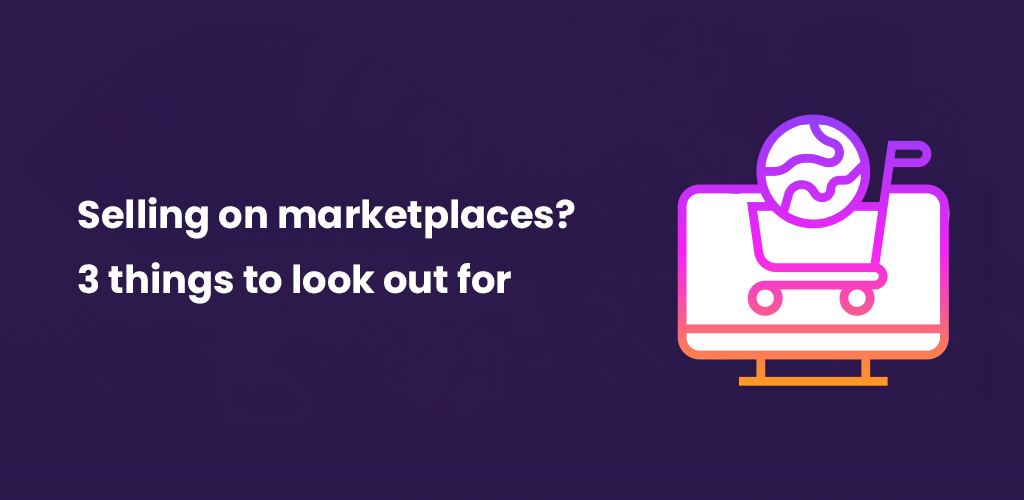Selling on marketplaces? 3 things to look out for
Selling on major marketplaces like Amazon and eBay can return a huge profit, but they are not without significant risk. In this post, we look at three issues that present potential issues for DropShippers – particularly on Amazon and eBay – and how best to avoid seller account suspension.
Amazon and eBay are often the first marketplaces that many sellers want to use, since the brand awareness and the sheer number of people using the platform on a daily basis presents huge opportunity to reach customers and make sales.
While they are undoubtedly the busiest platforms, they are also the ones that we hear sellers having the most issues with. Do even a minute or two of searching online and you’ll find numerous posts on seller forums from sellers who have found that Amazon has suspended their seller account with no warning. Fighting to get that decision overturned is a long and arduous process which frequently ends up with Amazon deciding that the account should be suspended permanently. Even if you’re successful, you can imagine how many potential sales your account could be missing out on until your account is activated again.
eBay tends to be a little less rigid in its approach and more open to listening, but sellers do still encounter similar problems on eBay. Sellers need to be extremely vigilant when it comes to their marketplace seller accounts, being aware of the terms and conditions and taking steps to avoid breaking them. There are three major things that all sellers, and particularly DropShippers, need to be aware of.
Intellectual property rights (branded goods) and authenticity claims
We spoke about grey market goods recently on the blog. If you list an item on Amazon or eBay that is branded but that you don’t have authorisation from the brand owner to sell, then you need to tread carefully. Customers, or other businesses can complain to Amazon or eBay about your business or your listings, and intellectual property rights, or doubts about product authenticity is one of the biggest reasons that we hear seller accounts being suspended for.
When complaints of this nature are made to Amazon or eBay, seller listings or even accounts are often suspended pending documentation being provided by the seller to validate the supply chain. If the seller can’t provide that, then at best, their listings will be removed, and at worst, have their account suspended or completely terminated.
For Avasam users, this means one of two things:
- Opting to sell on other sales channels than these giant marketplaces
- If you do sell on them, choosing products that you sell incredibly carefully, not selling anything that could be accused of intellectual property rights infringement, or that could be accused of being fake
We go to great lengths to validate our suppliers and the products listed on the Avasam platform as well as setting out clear guidance around Prohibited Items in our Terms & Conditions. However, since we work with a wide range of suppliers, some of whom are the brand owners and others who source in the wholesalers market, we cannot guarantee that we will be able to provide the level of supporting documentation required by Amazon or eBay.
With all this in mind, we will very shortly be flagging items as ‘not suitable for selling on Amazon/eBay’ unless we have received specific guidance from our suppliers that they can provide the necessary support documentation or where the products are unbranded or can be considered generic.
Our advice here is to avoid listing any products on Amazon or eBay that we have marked as ‘not suitable for selling on Amazon/eBay’. This is even more important for big brand products. We will do our best to protect our sellers but ultimately sellers are responsible for the products that they list on marketplaces.
New seller accounts
Since we added the ability for sellers to download our whole product catalogue, many sellers have chosen to list thousands more items on their sales channels using bulk upload tools, which greatly increases their volume potential. For established sellers, who have been listing on Amazon or eBay for a while, this doesn’t usually present a problem – but for sellers who have only recently set up their accounts, it sometimes can be an issue that leads to their account being shut down.
When you’re scaling up your business, it is tempting to list, and sell as many products as possible on as many sales channels as possible. But where marketplaces make spot checks, looking for identification and proof of ownership of the products that you’re selling, this can become a problem – in some cases this can halt a business before it can even get going. Since DropShipping by definition means the business doesn’t own the items ahead of the sale being made, it is not possible to have that proof ahead of time.
Although we have extensive experience in the field of eCommerce and supporting sellers and we will do our best to assist sellers who receive this type of request from Amazon or eBay, we cannot guarantee that they will accept our documentation.
Therefore, we advise that sellers with new marketplace accounts, particularly Amazon and eBay, should start small, selling just a few items at first, and then ramping up slowly as your track record and credibility as a seller increases.
Amazon seller performance metrics
Online marketplaces are all about protecting the end consumer and are therefore very hard on sellers that don’t meet their customer care guidelines, as we’re sure you’re already aware. Sellers are expected to meet targets for:
- Product dispatch times;
- Customer support responsiveness
- Dealing with returns and faulty items;
- Order cancellation rates; and
- The accuracy of product data, among others.
While we expect similarly high levels of service from our suppliers, as we have set out in our Terms and Conditions, we cannot guarantee that our suppliers will meet them every time – particularly with the current COVID-19 crisis.
Our advice here is to source products from just one or two suppliers as you start selling in bulk on your marketplace accounts. As your suppliers regularly meet targets for delivery and so on, your marketplace account will become stronger, and you can add additional suppliers. While we monitor sales and performance, you are responsible for compliance with marketplace rules, and you should monitor your performance on those channels, and change your suppliers on the Avasam platform if necessary.
For other marketplaces you should check the terms and conditions, and customer service requirements, then monitor the performance of your suppliers.
Should I avoid selling on Amazon and eBay?
Although it might seem as though we’re telling you that sellers should avoid selling on Amazon and eBay here, that really isn’t the case. Rather, we’re advising that you should consider if selling on those marketplaces is right for your business at this point and that you source the right products for the channel you are selling on. If it is, and you’re an experienced seller, then go ahead and do so – but do so carefully and intentionally, to avoid encountering any of the issues we have highlighted here.
If selling on Amazon or eBay isn’t the right move for your business, or you’re looking to mitigate the risk of losing sales if your seller account gets closed down, then listing on other sales channels is a good way to do this. Choosing your sales channels is an important part of your online business strategy, and we’ve discussed different sales channels on the blog before, most recently with OnBuy – who are doing great things to support sellers as their platform grows.
Of course, you may encounter the issues we’ve discussed here on other marketplaces too, so before you decide to list on any marketplace, be sure to read the seller terms and conditions. Forewarned is forearmed, and you’ll be able to mitigate the risks on those platforms, and to be prepared if you do encounter such issues.
Don’t forget, you can avoid many issues like these by selling through your own website. This is a much bigger strategy, and takes time to design, build and optimise – as well as getting customers to click through. But if you’re determined to be in eCommerce for the long run, then it is likely to be worth investing. Not only will you not be bound by terms and conditions set by the marketplaces, but you’ll also avoid paying listing fees or commission, and you’ll be building a brand that customers will look for outside of the marketplaces – which is invaluable for the success of your business.
What if I receive an Amazon complaint?
Sometimes when sellers receive a complaint from a brand owner, the brand owner will remove the issue from Amazon. However, many sellers struggle to find the Amazon Complaint ID to allow the brand owner to identify the right complaint, and to remove it.
Where to find an Amazon complaint ID number?
Here is where you can find an Amazon complaint ID number – note these instructions are not how to resolve a complaint, simply to find the ID.
- Go to your Amazon Account Health home page and under Policy Compliance, click on the violation or complaint.
- When the screen loads, you need to click on Appeal (found towards the right hand side)
- The complaint ID can be found on this screen, above the corrective action box
- DO NOT click Next as you do not want to submit any appeal until you are ready to proceed.
Once you have found this information, you’ll be able to contact the brand owner and raise the issue of the complaint with them.
Although some self-appointed experts claim that selling online is easy, we’ve always maintained that eCommerce is incredibly hard work. There are so many potential pitfalls that there is little wonder that so many sellers end up closing their business in the first year! Just to be clear, we’re definitely not saying don’t sell on Amazon or eBay – many DropShippers do so very successfully. Our advice to Avasam users is as follows:
- Avoid listing on Amazon or eBay any of the products in our catalogue that we have marked as unsuitable;
- If you choose to sell on a marketplace, start selling a few items from Avasam to gain a better seller rating before scaling up;
- Work carefully with the suppliers on Avasam to ensure they provide the service levels that the sales channel requires;
- Ensure you know the terms and conditions for the sales channels that you’re selling on; and
- List your inventory on a number of sales channels, so if you encounter a problem on one, your business doesn’t grind to a halt
When you’re starting to sell using DropShipping on any marketplace, but especially Amazon and eBay, knowing where those pitfalls are can help you to avoid them in the first place. If you have any questions about any of these issues, or how to integrate Avasam with sales channels other than Amazon and eBay, book a call or get in touch.




DropShip products from verified suppliers to diversify your inventory and scale your eCommerce business